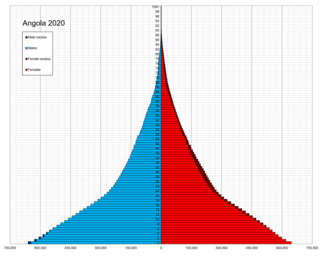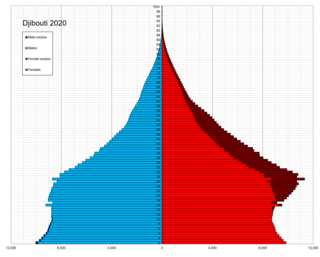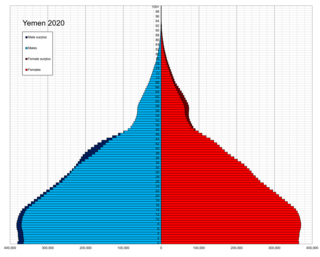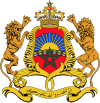| Demographics of Morocco | |
|---|---|
 Population pyramid of Morocco in 2020 | |
| Population | 37,841,363 (2022 est.) |
| Growth rate | 1.31% (2022 est.) |
| Birth rate | 17.42 births/1,000 population (2022 est.) |
| Death rate | 6.6 deaths/1,000 population (2022 est.) |
| Life expectancy | 73.68 years |
| • male | 71.98 years |
| • female | 75.46 years (2022 est.) |
| Fertility rate | 2.27 children born/woman (2022 est.) |
| Infant mortality rate | 19.2 deaths/1,000 live births |
| Net migration rate | -1.74 migrant(s)/1,000 population (2022 est.) |
| Age structure | |
| 0–14 years | 27.04% |
| 65 and over | 7.11% |
| Sex ratio | |
| Total | 1 male(s)/female (2022 est.) |
| At birth | 1.05 male(s)/female |
| Under 15 | 1.04 male(s)/female |
| 65 and over | 0.81 male(s)/female |
| Nationality | |
| Nationality | Moroccan |
| Major ethnic | In 2000: Arabs (44%) [1] |
| Minor ethnic | Arabized Berbers (24%) Other Berbers (21%) Beidane (10%) Other (1%) [1] |
| Language | |
| Official | Arabic, Berber |
| Spoken | Arabic, Berber |
Demographic features of the population of Morocco include population density, ethnicity, education level, health of the populace, economic status, religious affiliations and other aspects of the population. The population of Morocco in 2021 is 37.271 million. [2]
Contents
- Population
- Vital statistics
- Current vital statistics
- Fertility rate (The Demographic Health Survey)
- Life expectancy
- Structure of the population
- Ethnic groups
- Languages
- Main populated areas
- Education
- Other demographic statistics
- Population 2
- Religions
- Age structure
- Median age
- Population growth rate
- Total fertility rate
- Birth rate
- Death rate
- Net migration rate
- Contraceptive prevalence rate
- Urbanization
- Sex ratio
- Infant mortality rate
- Life expectancy at birth
- Ethnic groups 2
- Languages 2
- Literacy
- School life expectancy (primary to tertiary education)
- Major infectious diseases
- Unemployment, youth ages 15–24
- References
- External links

Moroccans are primarily of Arab and Berber origin. [3] [4] [1] Socially, there are two contrasting groups of Moroccans: those living in the cities and those in the rural areas. Among the rural, several classes have formed such as landowners, peasants, and tenant farmers. Moroccans live mainly in the north and west portions of Morocco. However, they prefer living in the more fertile regions near the Mediterranean Sea.
Between the Nile and the Red Sea were living Arab tribes expelled from Arabia for their turbulence, Banu Hilal and Banu Sulaym, who often plundered farming areas in the Nile Valley. [5] According to Ibn Khaldun, whole tribes set off with women, children, ancestors, animals and camping equipment. [5] These tribes, along with others, who mass arrived in the region of Morocco in colossal numbers around the 12th-13th centuries, [6] and later the Ma'qil in the 14th century, contributed to a more extensive ethnic, cultural, and linguistic Arabization of Morocco over time, especially beyond the major urban centres and the northern regions well into the countryside. [7] [6] The descendants of the original Arab settlers who continue to speak Arabic as a first language currently form the single largest population group in North Africa. [8]
About 99% of Moroccans are considered to be Sunni Muslims religiously or culturally. The numbers of the Jewish minority has decreased significantly since the creation of the State of Israel in 1948. Today there are 2,500 Moroccan Jews inside the country. [9] Thousands of Moroccan Jews living in Europe, Israel and North America visit the country regularly. There is a small but apparently growing minority of Moroccan Christians made of local Moroccan converts (not Europeans). In 2014, most of the 86,206 foreign residents are French people, Spaniards, Algerians and sub-Saharan African students.

























